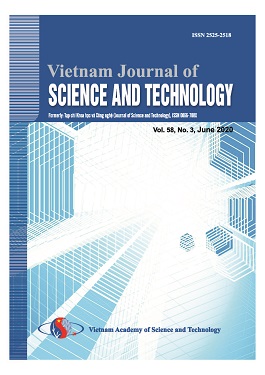Synthesis and antimicrobial activities of hydrazones derived from 4-hydroxy-3-nitrobenzaldehyde
Author affiliations
DOI:
https://doi.org/10.15625/2525-2518/17073Keywords:
4-hydroxy-3-nitrobenzaldehyde, benzo[d]thiazole, hydrazone, microwaveAbstract
A method using transistors based on semiconducting carbon nanotubes were developed for the real-time monitoring of the electrophysiological responses of individual cells to histamine stimulation. Transistors with one or three floating electrodes were utilized to evaluate histamine-induced Ca2+ influx into Hela cells via recording the conductance changes of the transistors. The Hela cells were directly cultured on the semiconducting carbon nanotube junction area of the transistors. The Ca2+ influx resulted from the activation of histamine H1 receptors embedded on the cell membranes by histamine, which generated a temporary negative potential at the gap between the cell and the transistor. The addition of histamine therefore increased the conductance of the p-type transistors. Moreover, the antihistamine effects of chlorpheniramine on histamine-induced Ca2+ influx were also investigated using a transistor including three floating electrodes. The data showed that chlorpheniramine partial reduced the increase in the conductance of the transistor during the addition of histamine, indicating the antihistamine activity of chlorpheniramine. Especially, only a single transistor was applied to repeat the measurements of the responses of multiple Hela cells pretreated with chlorpheniramine to histamine stimulation. This allows us to acquire data without being suffered from device-to-device variations, implying that our method would be a simple yet powerful one for applications of nanoscale biosensors for electrophysiological studies.Downloads
References
Mohareb, R.M., EL-Sharkawy K. A, Farouk F. O. A. Synthesis, cytotoxicity against cancer and normal cell lines of novel hydrazide–hydrazone derivatives bearing 5H-chromen-5-one. Med. Chem. Res. 28 (2019), 1885–1900. doi.org/10.1007/S00044-019-02421-6.
Kumar D., Kumar N. M., Ghosh S., Shah K., Novel bis(indolyl)hydrazide-hydrazones as potent cytotoxic agents. Bioorganic Med. Chem. Lett. 22(2012), 212–215. doi.org/10.1016 / j.bmcl.2011.11.031.
John S. F., Aniemeke E., Ngan P. H., Chong C. R., Gu P., Zhou J., Zhang Y., Graviss E., Liu J. O., Olaleye O. A., Characterization of 2-hydroxy-1-naphthaldehyde isonicotinoyl hydrazone as a novel inhibitor of methionine aminopeptidases from Mycobacterium tuberculosis, Tuberculosis, 101 (2016) S73-S77. doi.org/10.1016/j.tube.2016.09.025.
Bonnett S.A., Dennison D., Files M., Bajpai A., Parish T. A class of hydrazones are active against nonreplicating Mycobacterium tuberculosis. PLoS One. 13 (2018), 1-11. doi.org/10.1371/journal.pone.0198059.
De Miranda A. S., Júnior W. B., Da Silva Y. K. C., Alexandre-Moreira M. S., Castro R. P., Sabino J. R., Lião L. M., Lima L. M., Barreiro E. J. Design, synthesis, antinociceptive and anti-inflammatory activities of novel piroxicam analogues. Molecules. 17(2012), 14126–14145. doi.org/10.3390%2Fmolecules171214126.
Nikiforchin. R. N. Comparative evaluation of antimicrobial properties of actinomyces isolated from the patients with pulmonary tuberculosis, treated with phthivazid and streptomycin. Probl Tuberk. 49(1971), 66-71.
Meyer-Rohn J. S. P. Experimental and clinical experiences with isonicotinoylhydrazone-D-glucuronic-acid-lactone (Gluronazid). Der Hautarzt. 22 (1971). 105-110.
Chatterjee S. N., Ghosh S. Mechanism of action of furazolidone: inter-stand cross-linkage in DNA & liquid holding recovery of Vibrio cholerae cells. Indian J. Biochem. Biophys. 16 (1979),125-130.
McCalla D.R., Reuvers A. and Kaiser C. Mode of action of nitro-furazone. J. Bacteriol. 104 (1970), 1126-1134. doi.org/ 10.1128/jb.104.3.1126-1134.1970
Munoz-Davila M.J. Role of old antibiotics in the Era of antibiotic resistance. Highlighted nitrofuranation for the treatment of lower urinary tract infections. Antibiotics, 3(2014), 39-48. doi.org/ 10.3390/antibiotics3010039
Hoan D. Q., Tuyet V. T. A., Duong L. T., Hien N., Preparation of some new benzo[d]thiazole derivatives, Vietnam J. Chem. Int. Ed. 55 (2017), 433–437. doi.org/10.15625/2525-2321.2017-00487
Mai N. T. N., Anh T. T. P., May P. T. T., Thao P. P., Trang N. V., Hoan D. Q., Preparation of some benzo[d]thiazole-containing acetohydrazide derivatives, J. Sci. HNUE, 64(2019), 3–10. doi.org/10.18173/2354-1059.2019-0039.
Siddiqui N., Sarafroz M., Alam M. M., Ahsan W. Synthesis, anticonvulsant and neurotoxicity evaluation of 5-carbomethoxybenzoxazole derivatives. Acta Pol. Pharm. 65(2008), 449–455.
Robert, D.J.K., Silverstein M., Webster F.X., Spectrometric Identification of Organic Compounds. John Wiley & Sons (2005).
Nguyen T. N. M., Duong Q. H., Vu T. A. T., Tran T. T. T., Duong K. L. and Trinh T. H.. An effective assembling of novel derivatives containing both benzo[d]thiazole and benzo[d]oxazole rings, Letter in Organic Chemistry, 17 (2020), 815 – 822. doi.org/10.2174/1570178617666200207104912.
Palla, G.; Pelizzi, G.; Predieri, G.; Vignali, C. Conformational study on N-acylhydrazones of aromatic aldehydes by NMR spectroscopy. Gazz. Chim. Ital., 112 (1982), 339.
Syakaev V. V., Podyachev S. N., Habicher W. D, Buzykin B. I., Latypov S. K., Konovalov A. I. NMR study of conformation and isomerization of aryl- and heteroarylaldehyde 4-tert-butylphenoxyacetylhydrazones, J. Mol. Struct. 788 (2006) 55–62. doi.org/10.1016/j.molstruc.2005.11.018.
Himmerlreich, U.; Tschwatschal, F.; Borsdorf, R. NMR-spektroskopische Untersuchungen an Derivaten des 2,4-Dichlorphenoxyessigsäurehydrazids. Monatsh. Chem. 124 (1993), 1041-1051. doi.org/10.1007/BF00814150.
Downloads
Published
How to Cite
Issue
Section
License

This work is licensed under a Creative Commons Attribution-ShareAlike 4.0 International License.
Vietnam Journal of Sciences and Technology (VJST) is an open access and peer-reviewed journal. All academic publications could be made free to read and downloaded for everyone. In addition, articles are published under term of the Creative Commons Attribution-ShareAlike 4.0 International (CC BY-SA) Licence which permits use, distribution and reproduction in any medium, provided the original work is properly cited & ShareAlike terms followed.
Copyright on any research article published in VJST is retained by the respective author(s), without restrictions. Authors grant VAST Journals System a license to publish the article and identify itself as the original publisher. Upon author(s) by giving permission to VJST either via VJST journal portal or other channel to publish their research work in VJST agrees to all the terms and conditions of https://creativecommons.org/licenses/by-sa/4.0/ License and terms & condition set by VJST.
Authors have the responsibility of to secure all necessary copyright permissions for the use of 3rd-party materials in their manuscript.







 Vietnam Journal of Science and Technology (VJST) is pleased to notice:
Vietnam Journal of Science and Technology (VJST) is pleased to notice: